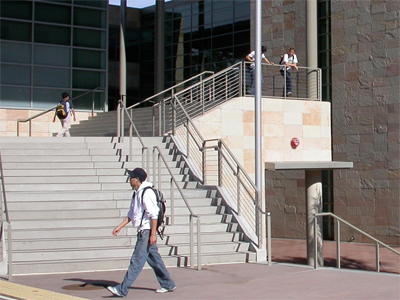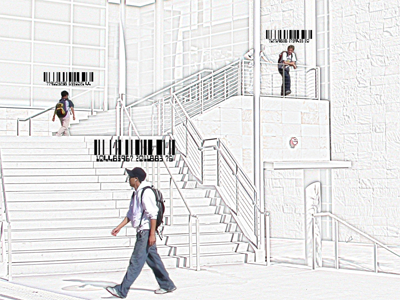The tracking device is a system
that recognizes people via their cell phones allowing the generation of individual sounds when they pass by. The output would be generated by mechanical instruments.
Personal surveillance comes in many forms, but the most prevalent and least obvious is the ordinary personal cellular device. Cellular phones are not generic pieces of electronics moving through a grid of towers. Instead, each phone contains its own serial number, a personal identifier for the device and, more importantly, for the user. A cellular system is designed to know the location and status of every phone in its network. An active database keeps track of which phones are on or off, which phones are making calls, and who has voice mail, text messages or any other personal information. Perhaps most significantly, all of this information travels through the public airwaves.

Cellular phones and towers have private (encoded) conversations to exchange this type of information. These 'conversations' are kept brief, just a few milliseconds every 15-20 minutes, to preserve battery life and privacy. Merely listening to signals sent by phones and towers would not be sufficient to retrieve a phone user's information. However, if 3rd party device were to trick a cellular phone into believing it was the base tower, a phone would hand over its serial number.

The binary information sent to and from cellular phones operates on multiple channels. Some channels contain voice packets, data packets, cellular operation data, and others. The channel that is used to administer system information is known as the paging channel. The paging channel is reserved for urgent messages to an individual phone. The tower uses this channel to notify the phone of incoming calls or voice mail. The cell tower could alert a phone that it has gotten too far away and will have to look for another tower. A cellular phone uses the paging channel to tell the tower where it is, to declare that it is turning its power off, or to request space on a voice channel to make a call.
The key function of the paging channel as it relates to this project, is phone registration. When a cellular phone powers on or has moved into the range of a new cell tower, it first must ask permission to have access to the network. It does this by sending a registration number to the tower that is compared to a system-wide database. The database recognizes the phone as a bill-paying customer and grants service to it.
We propose to create our own database of registration numbers. Because of the infrequency of the phone's registration with the tower, a more localized device will be fashioned to spoof the cellular towers registration request. Any idle phones will hand over their registration number that will be stored in our database.
A simple video motion detector will trigger the fake registration request. As a person walks into the system's space, the motion detector will trigger the fake request and, thus, probe the new visitor for a cellular phone. If a phone replies, the video tracking will follow the position of that person until they exit. Once out of the space, the phone will be musically and visually forgotten but stored in the database. Every time the phone returns, the system will find its registration number and the phones entire history kept in the database.
The video tracking will use contrast tracing to return information such as a person's movement within the space and their clothing color. The database will convert this information into a personal history, keeping track of visits, length of visits, action during visits, etc.
